TRANSITIONING
KNOWLEDGE
TRANSITIONING
KNOWLEDGE
TRANSITIONING
KNOWLEDGE
TRANSITIONING
KNOWLEDGE
TRANSITIONING
KNOWLEDGE
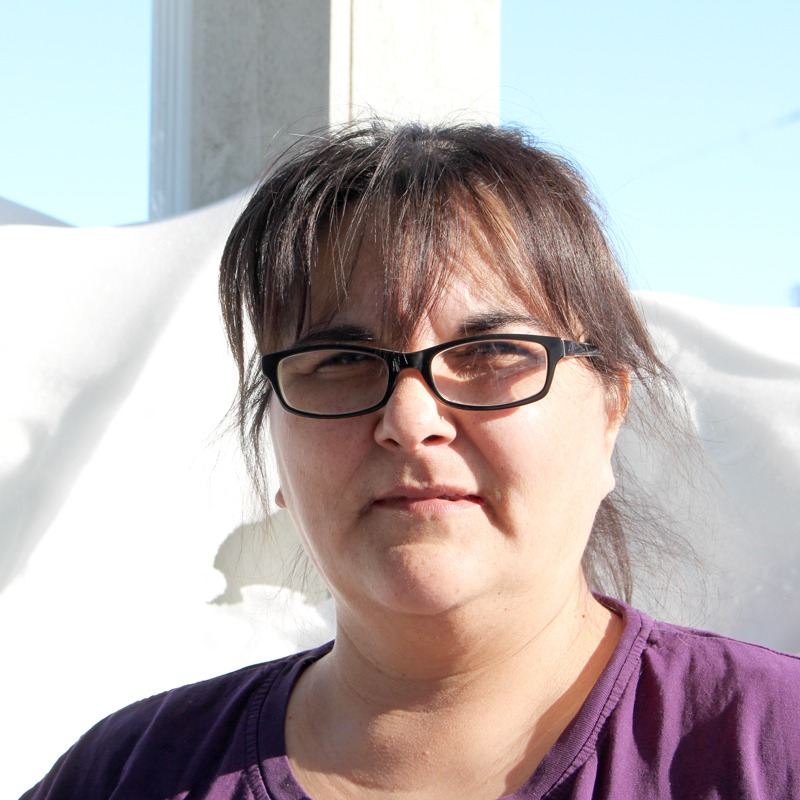
Carol Gear
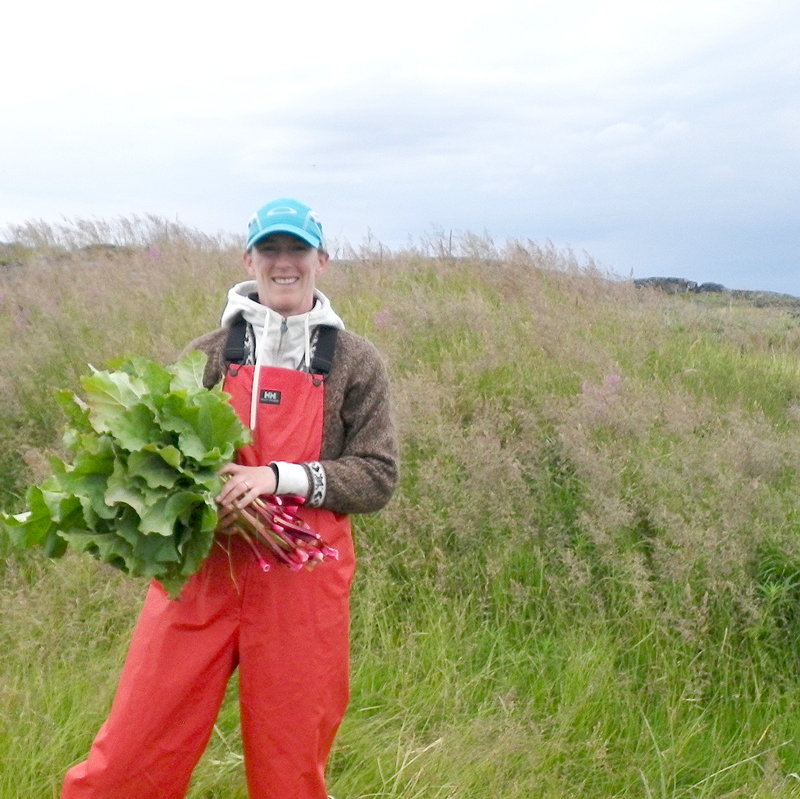
Dr. Erica Oberndorfer
Erica Oberndorfer
Reading the knowledge of plants
Carol Gear of Makkovik, Nunatsiavut, remembers growing up on Labrador’s North Coast and seeing wild irises along the shore. Her grandmother would always point them out to her and remind her that she could look, but never touch the delicate flowers.
“If you were caught picking those, you might as well have robbed a bank,” she chuckled. “They knew if we kept letting kids pick these, none [would be] left for others to enjoy.”
Ms. Gear says there have been many changes in the environment in and around Makkovik since she was a little girl, and that it is now rare to see one of the treasured flowers.
“This summer walking along the water with my daughter we found one of the irises. If my grandmother hadn’t instilled the knowledge [of the irises] in me, then my daughter would never have saw the flower, and wouldn’t have had the opportunity to learn about it.”
Reading the knowledge of plants
Carol Gear of Makkovik, Nunatsiavut, remembers growing up on Labrador’s North Coast and seeing wild irises along the shore. Her grandmother would always point them out to her and remind her that she could look, but never touch the delicate flowers.
“If you were caught picking those, you might as well have robbed a bank,” she chuckled. “They knew if we kept letting kids pick these, none [would be] left for others to enjoy.”
Ms. Gear says there have been many changes in the environment in and around Makkovik since she was a little girl, and that it is now rare to see one of the treasured flowers.
“This summer walking along the water with my daughter we found one of the irises. If my grandmother hadn’t instilled the knowledge [of the irises] in me, then my daughter would never have saw the flower, and wouldn’t have had the opportunity to learn about it.”
Reading the knowledge of plants
Carol Gear of Makkovik, Nunatsiavut, remembers growing up on the Labrador North Coast and seeing wild irises along the shore. Her grandmother would always point them out to her and instilled in her that she must always look, but never touch the delicate flowers.
“If you were caught picking those, you might as well have robbed a bank,” she chuckled. “They knew if we kept letting kids pick these, none [would be] left for others to enjoy.”
Ms. Gear says there have been many changes in the environment in and around Makkovik since she was a little girl, and that it is now rare to see one of the treasured flowers.
“This summer walking along the water with my daughter we found one of the irises. If my grandmother hadn’t instilled the knowledge [of the irises] in me, then my daughter would never have saw the flower, and wouldn’t have had the opportunity to learn about it.”
Reading the knowledge of plants
Carol Gear of Makkovik, Nunatsiavut, remembers growing up on Labrador’s North Coast and seeing wild irises along the shore. Her grandmother would always point them out to her and remind her that she could look, but never touch the delicate flowers.
“If you were caught picking those, you might as well have robbed a bank,” she chuckled. “They knew if we kept letting kids pick these, none [would be] left for others to enjoy.”
Ms. Gear says there have been many changes in the environment in and around Makkovik since she was a little girl, and that it is now rare to see one of the treasured flowers.
“This summer walking along the water with my daughter we found one of the irises. If my grandmother hadn’t instilled the knowledge [of the irises] in me, then my daughter would never have saw the flower, and wouldn’t have had the opportunity to learn about it.”
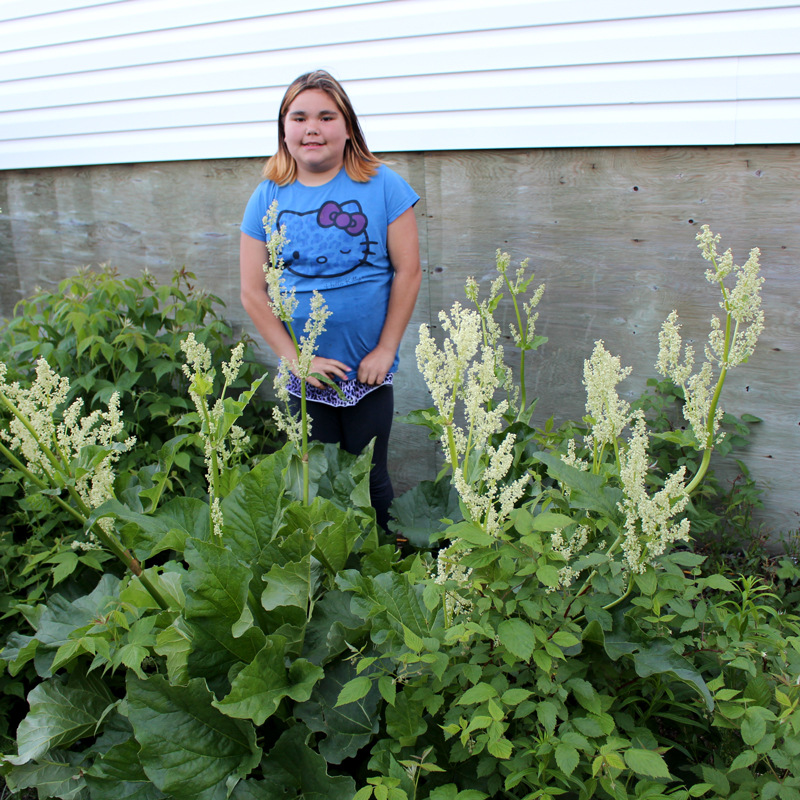
Hannah Gear, Carol’s daughter, with a rhubarb patch that came from her great-grandmother
It is these relationships between plants and Makkovimiut (residents of Makkovik) that interest Dr. Erica Oberndorfer. Dr. Oberndorfer earned her PhD from Carleton University and was a 2016-18 Tradition and Transition post-doctoral fellow based at the Labrador Institute.
Tradition and Transition is a five-year partnership between the Nunatsiavut Government, the self-governing body representing the Inuit of Northern Labrador, and Memorial University of Newfoundland. The goal of the partnership is to ensure the continuing vitality of Labrador Inuit culture.
Dr. Oberndorfer has worked closely with Makkovimiut since 2012. Through preliminary research discussions, residents determined the best use of her studies was a collaboration to turn their traditional knowledge into a book for the community.
Hands-on resource
The book explores family places, how people lived and the reasons plants were, and still are, important in the day-to-day life of Makkovimiut.
“We hope it will be a resource for people to share their own family stories, and a way for young people to learn about plants in context of their families’ lives,” said Dr. Oberndorfer.
For Ms. Gear, it is about taking stock in the wisdom of the people of her home, something she says folks in Makkovik often overlook because these are things they have done for generations.
“You don’t realize these connections because it’s a daily chore—because you just go and do it,” she explained. “It’s about stopping and noticing what we have and being thankful for what we have because it may not always be there.”
It is these relationships between plants and Makkovimiut (residents of Makkovik) that interest Dr. Erica Oberndorfer. Dr. Oberndorfer earned her PhD from Carleton University and was a 2016-18 Tradition and Transition post-doctoral fellow based at the Labrador Institute.
Tradition and Transition is a five-year partnership between the Nunatsiavut Government, the self-governing body representing the Inuit of Northern Labrador, and Memorial University of Newfoundland. The goal of the partnership is to ensure the continuing vitality of Labrador Inuit culture.
Dr. Oberndorfer has worked closely with Makkovimiut since 2012. Through preliminary research discussions, residents determined the best use of her studies was a collaboration to turn their traditional knowledge into a book for the community.
Hands-on resource
The book explores family places, how people lived and the reasons plants were, and still are, important in the day-to-day life of Makkovimiut.
“We hope it will be a resource for people to share their own family stories, and a way for young people to learn about plants in context of their families’ lives,” said Dr. Oberndorfer.
For Ms. Gear, it is about taking stock in the wisdom of the people of her home, something she says folks in Makkovik often overlook because these are things they have done for generations.
“You don’t realize these connections because it’s a daily chore — because you just go and do it,” she explained. “It’s about stopping and noticing what we have and being thankful for what we have because it may not always be there.”
It is these relationships between plants and Makkovimiut (residents of Makkovik) that interest Dr. Erica Oberndorfer. Dr. Oberndorfer earned her PhD from Carleton University and was a 2016-18 Tradition and Transition post-doctoral fellow based at the Labrador Institute.
Tradition and Transition is a five-year partnership between the Nunatsiavut Government, the self-governing body representing the Inuit of Northern Labrador, and Memorial University of Newfoundland. The goal of the partnership is to ensure the continuing vitality of Labrador Inuit culture.
Dr. Oberndorfer has worked closely with Makkovimiut since 2012. Through preliminary research discussions, residents determined the best use of her studies was a collaboration to turn their traditional knowledge into a book for the community.
Hands-on resource
The book explores family places, how people lived and the reasons plants were, and still are, important in the day-to-day life of Makkovimiut.
“We hope it will be a resource for people to share their own family stories, and a way for young people to learn about plants in context of their families’ lives,” said Dr. Oberndorfer.
For Ms. Gear, it is about taking stock in the wisdom of the people of her home, something she says folks in Makkovik often overlook because these are things they have done for generations.
“You don’t realize these connections because it’s a daily chore — because you just go and do it,” she explained. “It’s about stopping and noticing what we have and being thankful for what we have because it may not always be there.”
It is these relationships between plants and Makkovimiut (residents of Makkovik) that interest Dr. Erica Oberndorfer. Dr. Oberndorfer earned her PhD from Carleton University and was a 2016-18 Tradition and Transition post-doctoral fellow based at the Labrador Institute.
Tradition and Transition is a five-year partnership between the Nunatsiavut Government, the self-governing body representing the Inuit of Northern Labrador, and Memorial University of Newfoundland. The goal of the partnership is to ensure the continuing vitality of Labrador Inuit culture.
Dr. Oberndorfer has worked closely with Makkovimiut since 2012. Through preliminary research discussions, residents determined the best use of her studies was a collaboration to turn their traditional knowledge into a book for the community.
Hands-on resource
The book explores family places, how people lived and the reasons plants were, and still are, important in the day-to-day life of Makkovimiut.
“We hope it will be a resource for people to share their own family stories, and a way for young people to learn about plants in context of their families’ lives,” said Dr. Oberndorfer.
For Ms. Gear, it is about taking stock in the wisdom of the people of her home, something she says folks in Makkovik often overlook because these are things they have done for generations.
“You don’t realize these connections because it’s a daily chore — because you just go and do it,” she explained. “It’s about stopping and noticing what we have and being thankful for what we have because it may not always be there.”
It is these relationships between plants and Makkovimiut (residents of Makkovik) that interest Dr. Erica Oberndorfer. Dr. Oberndorfer earned her PhD from Carleton University and was a 2016-18 Tradition and Transition post-doctoral fellow based at the Labrador Institute.
Tradition and Transition is a five-year partnership between the Nunatsiavut Government, the self-governing body representing the Inuit of Northern Labrador, and Memorial University of Newfoundland. The goal of the partnership is to ensure the continuing vitality of Labrador Inuit culture.
Dr. Oberndorfer has worked closely with Makkovimiut since 2012. Through preliminary research discussions, residents determined the best use of her studies was a collaboration to turn their traditional knowledge into a book for the community.
Hands-on resource
The book explores family places, how people lived and the reasons plants were, and still are, important in the day-to-day life of Makkovimiut.
“We hope it will be a resource for people to share their own family stories, and a way for young people to learn about plants in context of their families’ lives,” said Dr. Oberndorfer.
For Ms. Gear, it is about taking stock in the wisdom of the people of her home, something she says folks in Makkovik often overlook because these are things they have done for generations.
“You don’t realize these connections because it’s a daily chore — because you just go and do it,” she explained. “It’s about stopping and noticing what we have and being thankful for what we have because it may not always be there.”
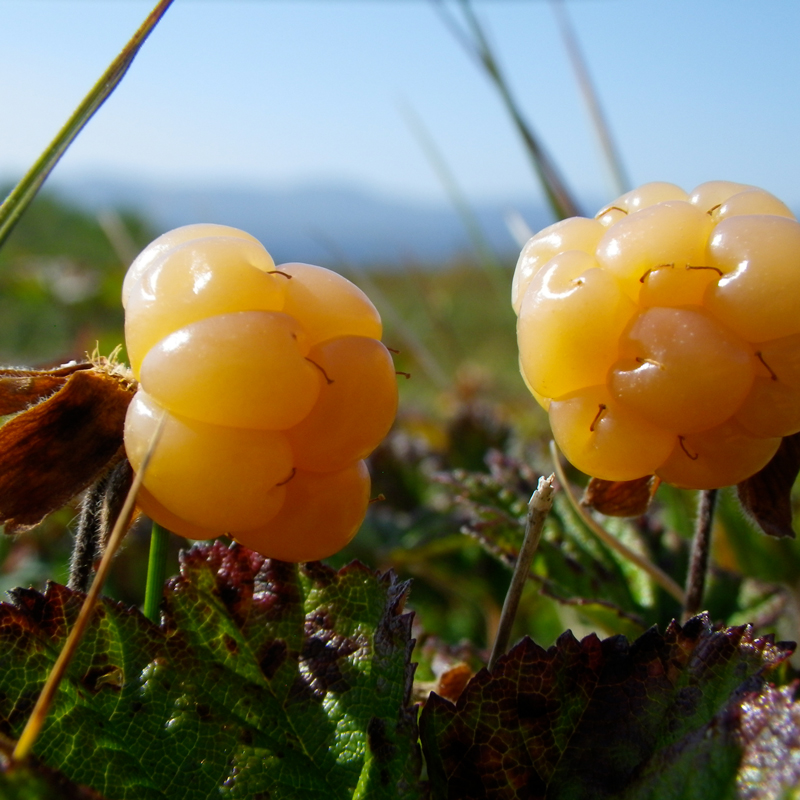
Bakeapples are a favourite berry for eating and baking in Makkovik, and help keep colds away
Ms. Gear says that Makkovik is changing. The community is expanding, berry patches are being replaced with development, new species are being introduced and old ways are being forgotten.
“Over the last few years we’ve lost so many Elders and so many people who worked with plants and used plants as part of their living,” she said.
While there are old ways that are being discontinued, there are also traditions that continue as strongly as ever. Because many of these practices are well-integrated into daily life, it takes time for visitors to fathom the extraordinary plant knowledge that is often hidden in plain sight.
“Makkovimiut work with plants in ways that are ingenious but are second nature to people,” said Dr. Oberndorfer. “A visiting researcher who doesn’t have that same experience sometimes puts people on the spot asking them about their knowledge.
“It’s like asking Wayne Gretzky to please explain how he shoots the puck—where’s he supposed to start? But if you get to know people gradually and chat about everything, not just plants, that’s when you start to hear stories of plants in context, and about the resourcefulness of people.”
Community-based research
Dr. Oberndorfer has become a fixture in Makkovik, participating in community life and sharing her research findings. She checks in regularly with plant mentors to make sure they are OK with every step of the process.
Ms. Gear says that Makkovik is changing. The community is expanding, berry patches are being replaced with development, new species are being introduced and old ways are being forgotten.
“Over the last few years we’ve lost so many Elders and so many people who worked with plants and used plants as part of their living,” she said.
While there are old ways that are being discontinued, there are also traditions that continue as strongly as ever. Because many of these practices are well-integrated into daily life, it takes time for visitors to fathom the extraordinary plant knowledge that is often hidden in plain sight.
“Makkovimiut work with plants in ways that are ingenious but are second nature to people,” said Dr. Oberndorfer. “A visiting researcher who doesn’t have that same experience sometimes puts people on the spot asking them about their knowledge.
“It’s like asking Wayne Gretzky to please explain how he shoots the puck – where’s he supposed to start? But if you get to know people gradually and chat about everything, not just plants, that’s when you start to hear stories of plants in context, and about the resourcefulness of people.”
Community-based research
Dr. Oberndorfer has become a fixture in Makkovik, participating in community life and sharing her research findings. She checks in regularly with plant mentors to make sure they are OK with every step of the process.
Ms. Gear says that Makkovik is changing. The community is expanding, berry patches are being replaced with development, new species are being introduced and old ways are being forgotten.
“Over the last few years we’ve lost so many Elders and so many people who worked with plants and used plants as part of their living,” she said.
While there are old ways that are being discontinued, there are also traditions that continue as strongly as ever. Because many of these practices are well-integrated into daily life, it takes time for visitors to fathom the extraordinary plant knowledge that is often hidden in plain sight.
“Makkovimiut work with plants in ways that are ingenious but are second nature to people,” said Dr. Oberndorfer. “A visiting researcher who doesn’t have that same experience sometimes puts people on the spot asking them about their knowledge.
“It’s like asking Wayne Gretzky to please explain how he shoots the puck – where’s he supposed to start? But if you get to know people gradually and chat about everything, not just plants, that’s when you start to hear stories of plants in context, and about the resourcefulness of people.”
Community-based research
Dr. Oberndorfer has become a fixture in Makkovik, participating in community life and sharing her research findings. She checks in regularly with plant mentors to make sure they are OK with every step of the process.
Ms. Gear says that Makkovik is changing. The community is expanding, berry patches are being replaced with development, new species are being introduced and old ways are being forgotten.
“Over the last few years we’ve lost so many Elders and so many people who worked with plants and used plants as part of their living,” she said.
While there are old ways that are being discontinued, there are also traditions that continue as strongly as ever. Because many of these practices are well-integrated into daily life, it takes time for visitors to fathom the extraordinary plant knowledge that is often hidden in plain sight.
“Makkovimiut work with plants in ways that are ingenious but are second nature to people,” said Dr. Oberndorfer. “A visiting researcher who doesn’t have that same experience sometimes puts people on the spot asking them about their knowledge.
“It’s like asking Wayne Gretzky to please explain how he shoots the puck – where’s he supposed to start? But if you get to know people gradually and chat about everything, not just plants, that’s when you start to hear stories of plants in context, and about the resourcefulness of people.”
Community-based research
Dr. Oberndorfer has become a fixture in Makkovik, participating in community life and sharing her research findings. She checks in regularly with plant mentors to make sure they are OK with every step of the process.
Ms. Gear says that Makkovik is changing. The community is expanding, berry patches are being replaced with development, new species are being introduced and old ways are being forgotten.
“Over the last few years we’ve lost so many Elders and so many people who worked with plants and used plants as part of their living,” she said.
While there are old ways that are being discontinued, there are also traditions that continue as strongly as ever. Because many of these practices are well-integrated into daily life, it takes time for visitors to fathom the extraordinary plant knowledge that is often hidden in plain sight.
“Makkovimiut work with plants in ways that are ingenious but are second nature to people,” said Dr. Oberndorfer. “A visiting researcher who doesn’t have that same experience sometimes puts people on the spot asking them about their knowledge.
“It’s like asking Wayne Gretzky to please explain how he shoots the puck – where’s he supposed to start? But if you get to know people gradually and chat about everything, not just plants, that’s when you start to hear stories of plants in context, and about the resourcefulness of people.”
Community-based research
Dr. Oberndorfer has become a fixture in Makkovik, participating in community life and sharing her research findings. She checks in regularly with plant mentors to make sure they are OK with every step of the process.
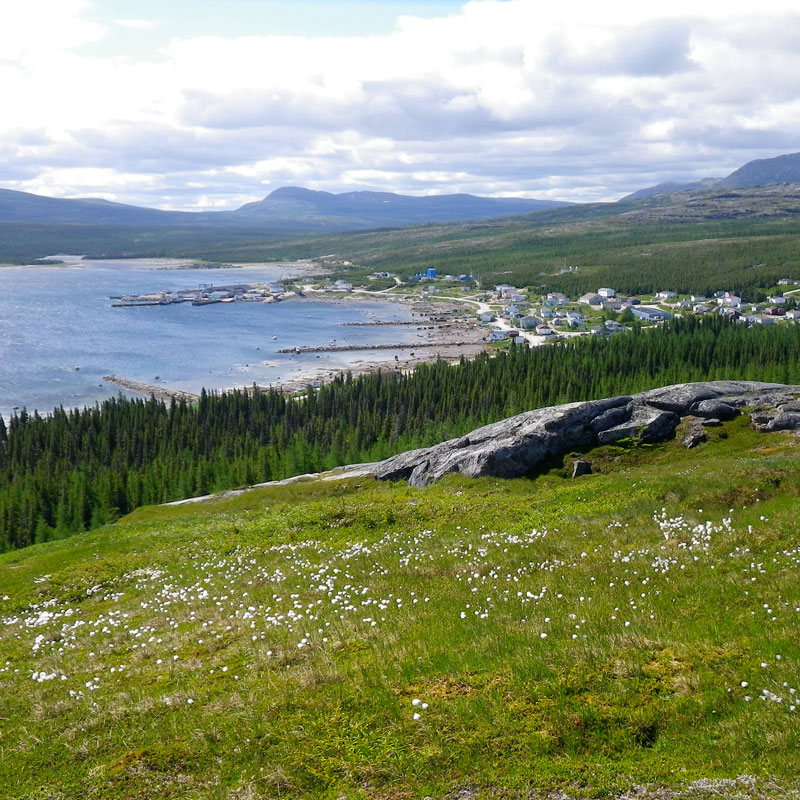
Cotton grass (also called Arctic cotton) growing on Makkovik Hill in July
Cotton grass (also called Arctic cotton) growing on Makkovik Hill in July
Cotton grass (also called Arctic cotton) growing on Makkovik Hill in July
Cotton grass (also called Arctic cotton) growing on Makkovik Hill in July
Dr. Max Liboiron, associate vice-president (Indigenous research) pro tempore, says this community-focused approach is key to working with Indigenous communities.
“Dr. Oberndorfer’s community-based approach to research is exemplary of not only best practices for doing research with Indigenous groups, but a deep commitment to the plants, animals and land of Makkovik,” she said.
“The way she lives in Labrador, works with Makkovik plant mentors, and weaves together beautiful stories about plants and people in a thoughtful way, has earned her a stellar reputation in both community and academic spaces. Memorial is fortunate to be associated with researchers like her.
All of Dr. Oberndorfer’s research is being kept in the community museum, a collaborative approach that Ms. Gear supports.
“All the information is back here, and that’s where it should be,” she said. “A lot of researchers will come in and they’ll do one interview and think they have all they need. Then they leave and you find out later it was reported wrong. They just came in, got the information, and they’re gone without reporting back to the community. Erica is doing it right.”
For her part, Dr. Oberndorfer sees a guiding value at work when Ms. Gear highlights the contributions of others before her own—that of thinking of others, in everything you do.
“Many plant mentors speak of leaving berry patches close to town for Elders to pick from, or harvesting enough to share with others. The first thought is for the people around you, and how your words and actions affect them. That’s a value to pay attention to in research. If this project accomplishes anything good, it’s because Makkovimiut have laid the foundation by demonstrating the ways to build respectful relationships.”
A version of this story was originally published in the May 2017 Tradition and Transition newsletter. It is available online.
Dr. Max Liboiron, associate vice-president (Indigenous research) pro tempore, says this community-focused approach is key to working with Indigenous communities.
“Dr. Oberndorfer’s community-based approach to research is exemplary of not only best practices for doing research with Indigenous groups, but a deep commitment to the plants, animals and land of Makkovik,” she said.
“The way she lives in Labrador, works with Makkovik plant mentors, and weaves together beautiful stories about plants and people in a thoughtful way, has earned her a stellar reputation in both community and academic spaces. Memorial is fortunate to be associated with researchers like her.”
All of Dr. Oberndorfer’s research is being kept in the community museum, a collaborative approach that Ms. Gear supports.
“All the information is back here, and that’s where it should be,” she said. “A lot of researchers will come in and they’ll do one interview and think they have all they need. Then they leave and you find out later it was reported wrong. They just came in, got the information, and they’re gone without reporting back to the community. Erica is doing it right.”
For her part, Dr. Oberndorfer sees a guiding value at work when Ms. Gear highlights the contributions of others before her own – that of thinking of others, in everything you do.
“Many plant mentors speak of leaving berry patches close to town for Elders to pick from, or harvesting enough to share with others. The first thought is for the people around you, and how your words and actions affect them. That’s a value to pay attention to in research. If this project accomplishes anything good, it’s because Makkovimiut have laid the foundation by demonstrating the ways to build respectful relationships.”
A version of this story was originally published in the May 2017 Tradition and Transition newsletter. It is available online.
Dr. Max Liboiron, associate vice-president (Indigenous research) pro tempore, says this community-focused approach is key to working with Indigenous communities.
“Dr. Oberndorfer’s community-based approach to research is exemplary of not only best practices for doing research with Indigenous groups, but a deep commitment to the plants, animals and land of Makkovik,” she said.
“The way she lives in Labrador, works with Makkovik plant mentors, and weaves together beautiful stories about plants and people in a thoughtful way, has earned her a stellar reputation in both community and academic spaces. Memorial is fortunate to be associated with researchers like her.”
All of Dr. Oberndorfer’s research is being kept in the community museum, a collaborative approach that Ms. Gear supports.
“All the information is back here, and that’s where it should be,” she said. “A lot of researchers will come in and they’ll do one interview and think they have all they need. Then they leave and you find out later it was reported wrong. They just came in, got the information, and they’re gone without reporting back to the community. Erica is doing it right.”
For her part, Dr. Oberndorfer sees a guiding value at work when Ms. Gear highlights the contributions of others before her own – that of thinking of others, in everything you do.
“Many plant mentors speak of leaving berry patches close to town for Elders to pick from, or harvesting enough to share with others. The first thought is for the people around you, and how your words and actions affect them. That’s a value to pay attention to in research. If this project accomplishes anything good, it’s because Makkovimiut have laid the foundation by demonstrating the ways to build respectful relationships.”
A version of this story was originally published in the May 2017 Tradition and Transition newsletter. It is available online.
Dr. Max Liboiron, associate vice-president (Indigenous research) pro tempore, says this community-focused approach is key to working with Indigenous communities.
“Dr. Oberndorfer’s community-based approach to research is exemplary of not only best practices for doing research with Indigenous groups, but a deep commitment to the plants, animals and land of Makkovik,” she said.
“The way she lives in Labrador, works with Makkovik plant mentors, and weaves together beautiful stories about plants and people in a thoughtful way, has earned her a stellar reputation in both community and academic spaces. Memorial is fortunate to be associated with researchers like her.”
All of Dr. Oberndorfer’s research is being kept in the community museum, a collaborative approach that Ms. Gear supports.
“All the information is back here, and that’s where it should be,” she said. “A lot of researchers will come in and they’ll do one interview and think they have all they need. Then they leave and you find out later it was reported wrong. They just came in, got the information, and they’re gone without reporting back to the community. Erica is doing it right.”
For her part, Dr. Oberndorfer sees a guiding value at work when Ms. Gear highlights the contributions of others before her own – that of thinking of others, in everything you do.
“Many plant mentors speak of leaving berry patches close to town for Elders to pick from, or harvesting enough to share with others. The first thought is for the people around you, and how your words and actions affect them. That’s a value to pay attention to in research. If this project accomplishes anything good, it’s because Makkovimiut have laid the foundation by demonstrating the ways to build respectful relationships.”
A version of this story was originally published in the May 2017 Tradition and Transition newsletter. It is available online.
Dr. Max Liboiron, associate vice-president (Indigenous research) pro tempore, says this community-focused approach is key to working with Indigenous communities.
“Dr. Oberndorfer’s community-based approach to research is exemplary of not only best practices for doing research with Indigenous groups, but a deep commitment to the plants, animals and land of Makkovik,” she said.
“The way she lives in Labrador, works with Makkovik plant mentors, and weaves together beautiful stories about plants and people in a thoughtful way, has earned her a stellar reputation in both community and academic spaces. Memorial is fortunate to be associated with researchers like her.”
All of Dr. Oberndorfer’s research is being kept in the community museum, a collaborative approach that Ms. Gear supports.
“All the information is back here, and that’s where it should be,” she said. “A lot of researchers will come in and they’ll do one interview and think they have all they need. Then they leave and you find out later it was reported wrong. They just came in, got the information, and they’re gone without reporting back to the community. Erica is doing it right.”
For her part, Dr. Oberndorfer sees a guiding value at work when Ms. Gear highlights the contributions of others before her own – that of thinking of others, in everything you do.
“Many plant mentors speak of leaving berry patches close to town for Elders to pick from, or harvesting enough to share with others. The first thought is for the people around you, and how your words and actions affect them. That’s a value to pay attention to in research. If this project accomplishes anything good, it’s because Makkovimiut have laid the foundation by demonstrating the ways to build respectful relationships.”
A version of this story was originally published in the May 2017 Tradition and Transition newsletter. It is available online.
MEMORIAL UNIVERSITY | Newfoundland and Labrador's University | OFFICE of THE PRESIDENT | president@mun.ca | 709 864 8212
MEMORIAL UNIVERSITY OF NEWFOUNDLAND | Newfoundland and Labrador's University | OFFICE of THE PRESIDENT | president@mun.ca | 709 864 8212
MEMORIAL UNIVERSITY OF NEWFOUNDLAND | Newfoundland and Labrador's University | OFFICE of THE PRESIDENT | president@mun.ca | 709 864 8212
MEMORIAL UNIVERSITY OF NEWFOUNDLAND | Newfoundland and Labrador's University
| OFFICE of THE PRESIDENT | president@mun.ca | 709 864 8212
OFFICE of THE PRESIDENT | president@mun.ca | 709 864 8212 |
MEMORIAL UNIVERSITY of NEWFOUNDLAND
